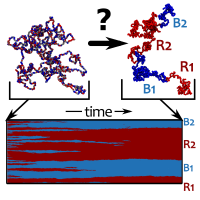How Do Cells Remember Who They Are? A "Recolourable" Polymer Model to Understand Epigenetic Memory.

A new theoretical model of DNA as a "recolourable" polymer may explain why specific "epigenetic" patterns on the genome can survive from one cell generation to the next and allow cellular memory.
Every cell in our body contains the same DNA. Nevertheless, a brain cell is clearly very different from, say, a liver cell, in terms of which genes are active and inactive. The specialisation into different types of cells is made possible by "epigenetics" (literally, "beyond the genetic information"). Epigenetics acts through biochemical markers called "post-translational modifications" which are deposited onto histone proteins -- the proteins needed to package the DNA inside the nucleus. Epigenetic marks vary from cell to cell, allowing each cell to have its own identity. Nonetheless, epigenetic marks are very dynamic: they are gained and lost by histones all the time, and many are removed during replication. This then begs the questions, how does a cell remember its own identity throughout its life and how is its identity passed down to the progeny cells when it divides?
Davide Michieletto, in collaboration with Davide Marenduzzo and Enzo Orlandini (Padova) have formulated a new model to address these questions. The model treats the complex of DNA and histones (also called "chromatin") as a polymer made of beads, where each bead corresponding to a few histones (with their corresponding DNA). In the model, the polymer beads are "coloured" based on their epigenetic state, and this can be changed dynamically mimicking the action of "writer" proteins, enzymes found in the cell. The epigenetic colour is then recognised by "readers", which model chromatin-bridging proteins which have an affinity for a given epigenetic mark. The model displays an abrupt first-order-like transition between a swollen and epigenetically "disordered" chromatin and a collapsed and "ordered" one, where the whole polymer has the same colour. The first order nature of the transition is important: it implies that there is hysteresis and memory, and the researchers have shown that, following a (simulated) replication event, the system is able to return to the same ordered state (so the corresponding cell will keep its identity).
The findings therefore strongly suggest that epigenetic memory may be made possible through a positive feedback loop between "reader" and "writer" proteins which couple the 1D epigenetic patterning to the 3D chromatin folding.

